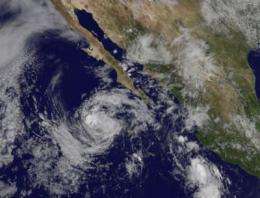Slow-moving Marty headed for drier air, cooler waters

Marty was still holding onto tropical storm status on September 18, with maximum sustained winds near 40 mph and taking a slow march through the Eastern Pacific Ocean.
At 11 a.m. EDT he was located about 360 miles west-southwest of the southern tip of Baja California, near 18.9 north and 112.4 west. Marty is moving near 7 mph and has a minimum central pressure near 1004 millibars. Over the past two days, he only moved 40 miles!
The GOES-11 satellite captured an image of Tropical Storm Marty off the western Mexican coast on September 18 at 12:45 p.m. EDT. GOES is operated by the National Oceanic and Atmospheric Administration. NASA's GOES Project, located at NASA's Goddard Space Flight Center, Greenbelt, Md. creates some of the satellite images from the GOES satellites.
The National Hurricane Center reported that there was a "burst of deep convection (rising air and thunderstorm development)" near Marty's center this morning, however, cloud top temperatures (as measured by NASA's Atmospheric Infrared Sounder (AIRS) instrument on the Aqua satellite) have begun to warm. Warming cloud top temperatures are indicative of thunderstorms that have less strength than those in stronger tropical cyclones.
Marty's fate over the weekend lies in cooler waters and drier air. Those are the two factors he's going to face as he continues moving, and they'll weaken him over the weekend. Marty will likely be a remnant low pressure area by the beginning of next week.
Source: NASA/Goddard Space Flight Center




















